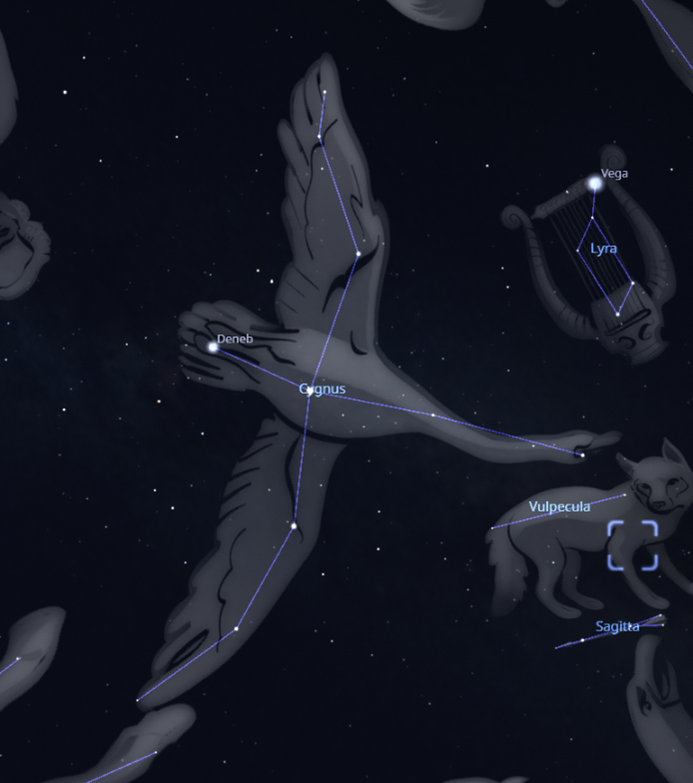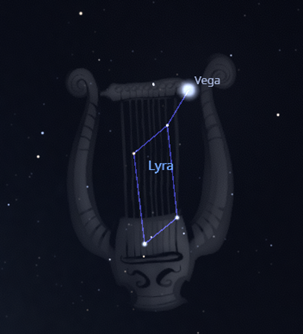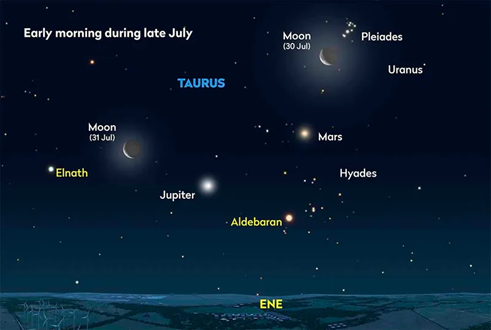What’s up July 2024
Summer is hopefully underway, and with good weather come clear skies. They might not be very dark or last very long but there is still plenty to explore across the summer night skies.
Long nights
During summer the northern hemisphere is tilted towards the sun, such that as we rotate we are illuminated by the Sun more than we are shaded. This means that the days for July are roughly 17 and a half hours long to start with, and will be 16 hours by the end of the month as we rotate round the sun and our inclination changes again. We will never see true astronomical darkness as the Sun is never more than approximately 20 degrees below the horizon throughout the night.
Constellations

Figure 1: The Summer Triangle.
Last month we focused on the Summer triangle, Lets take a deep dive into the constellations that make up the Summer Triangle.
Cygnus (The Swan):

Cygnus, often called the Northern Cross due to its cross-shaped asterism, is a prominent constellation that graces the summer skies. Located along the plane of the Milky Way, the swan swims along the milky river of our galaxy, making it an excellent region for observing dense star fields and the intricate structure of our galaxy. The brightest star in Cygnus is Deneb, which forms one vertex of the Summer Triangle. Deneb is a supergiant star and one of the most luminous stars visible in the night sky, lying about 2,600 light-years from Earth. This constellation is often associated with the Greek story of Zeus transforming into a swan.
Lyra (The Lyre):

Lyra is a small but mighty constellation, easily identified by its bright star Vega, which is one of the most luminous stars in the sky and a key component of the Summer Triangle. Vega is relatively close to Earth, at about 25 light-years away, and has been a cornerstone for many astronomical studies. Within Lyra, stargazers can also find the Ring Nebula (M57), a well-known planetary nebula that appears as a small, glowing blue ring through telescopes. Lyra represents the lyre of Orpheus in Greek mythology, a musical instrument said to have such enchanting melodies that it could charm all of creation, including inanimate objects and even the gods.
Aquila (The Eagle):

Aquila, known as the Eagle. It is characterized by the bright star Altair, one of the closest stars visible to the naked eye at only about 16.7 light-years from Earth, and its hammerhead /neck segment. Altair is also part of the Summer Triangle, alongside Vega and Deneb. Aquila is rich in mythological significance, often associated Zeus again, as the eagle that carried Zeus’s thunderbolts. This constellation also features several interesting deep-sky objects, including the open cluster NGC 6709. This is another bird that flies across the Milky way so again a good hunting zone for dense collections of stars.
Planets
Figure 2: image shows where Jupiter and Mars will be in relation to the Moon and stars thoughout the end of July in the East North East sky. credit :Skyatnight magazine
Mars, Jupiter and Saturn are your best catches this month. It won’t be easy as they are still in the pre-dawn sky, so you will have to stay up to 3am to catch them. Saturn is leading the planets across the sky, then Jupiter and Mars are close together. Wait till the end of the month and they will be appearing earlier in the night, in darker skies, so much easier to spot.
To spot a planet, look for the brightest objects in the sky. Focus your search along the ecliptic plane, which, for us in the UK, stretches from east to west near the southern horizon. This is because the ecliptic plane is where the planets of our solar system are located.
Planets are much closer to us than stars. Although they are smaller and do not produce their own light, they reflect sunlight more effectively, making them appear brighter and covering a larger area in the sky. Stars, on the other hand, appear only as pinpricks of light. The light from stars can be disrupted by our atmosphere, causing a twinkling effect due to changes in water vapor and temperature. Planets, being closer, can appear as disks through a telescope. While the light from planets can also be affected by atmospheric disturbances, their central area remains consistently illuminated, distinguishing them from the twinkling stars.
Moon Phases
5th; New Moon
13th: Half Moon
21st: Full Moon
28th: Half Moon
The full moon this month is known as the Buck Moon. This comes from male deer called bucks who shed and regrow their antlers annually. July is when all the antlers are coming back in full growth and bucks now look like bucks again.
Clears Skies and Happy Stargazing!

















